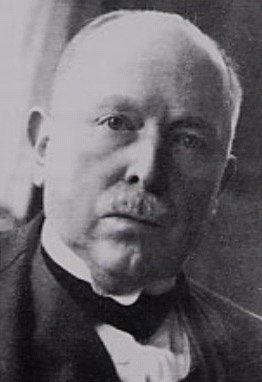 |
limbal girdle of Vogt = Corneal opacity that occurs in an arc concentric pattern and is adjacent to the limbus within the palpebral fissure at 3 and 9 o'clock; it is more common nasally than temporally, but it is frequently both.It is found in 60% of patients older than 40 years and occurs more frequently in women than in men.
Vogt's striae = Vertical stress lines seen deep in the affected stroma of keratoconus.
Vogt's anterior mosaic crocodile shagreen = Anterior mosaic crocodile
shagreen appears as bilateral, polygonal, grayish-white opacities in the
deep layers of the epithelium and in
Bowman's layer.
Vogt-Koyanagi-Harada (VKH) syndrome = it is a systemic inflammatory condition involving the eye, as well as other organs commoner in certain races.
Alfred Vogt attended the University of Basel and received his doctorate there in 1904. He then trained in ophthalmology in Basel under professor Carl Mellinger (1858-1917) and also visited Torino before he settled in private practice in 1906. In 1909 he became head physician at the cantonal eye clinic in Aarau, and in 1917 was appointed ausserordentlicher professor and director of the university eye clinic in Basel. In 1923 he accepted an invitation as director of the university eye clinic and ordentlicher Professor of the Zurich university eye clinic.
Vogt developed techniques for retinoscopy and the surgical management of retinal detachment. In 1913 he began using the newly constructed slit-lamp in conjunction with a corneal microscope to examine the structures of the anterior regions of the eye. This work resulted in his 3-volume textbook, first published in 1921. Vogt was a leading figure in ophthalmology and he received the prestigious Donders and Gullstrand medals for his achievements.
Vogt introduced cyclodiathermy for the treatment of glaucoma. Some believe that Francisco Goya suffered from this syndrome and that the sudden onset of deafness resulted in the dramatic change of his style from paintings which were colourful and gay to scenes depicting devastation and death characteristic of his “black period”.
His last years were darkened by the death of his son in an avalanche
in the Swiss Mountains, and by chronic ill-health due to a renal disorder.
- "Vogt was the omnipotent ruler, venerated by the resident and nursing
staff, second only to God. When he spoke, that was it, and nobody attempted
to argue."
His biographer
"The Zurich Eye Clinic under Professor Vogt certainly was an efficiently
run, hardworking and productive institute. Vogt kept close reins on the
staff and by strict discipline, which would make some of our contemporary
house staff shudder, produced maximal performance."
His biographer
- Damage to the Eye caused by Aniline Dye.
- Atlas der Spaltlampenmikroskopie des lebenden Auges.
- Zur Heilung der Netzhautablösung mittels Ignipunktur des Risses.
- F. W. Stocker:
- H. Schläpfer, H. Wagner:
Written while he worked with professor Carl Mellinger (1858-1917) in Basel.
Berlin, J. Springer, 1921.
Second edition greatly revised and enlarged. Volume 1-2, Springer, 1930-1931; volume 3, Stuttgart, F. Enke, 1942. English translation of volume 3, Zurich, 1947. Reprint of 2nd edition, Bonn, J. P. Wayenborgh, 1977. English translation by F. C. Blodi, 3 volumes, Bonn, J. P. Wayenborgh, 1978-1981. Also translated into French, and Italian.
Schweizerische medizinische Wochenschrift, Basel, 1933, 63: 825-827.
Professor Alfred Vogt (1879-1943).
Obituary. Archives of Ophthalmology, Chicago, 1944, 31: 172-174.
Remembrances of Things Past. 1923-1943: The era of Alfred Vogt.
Survey of Ophthalmology, Boston, 1974, 19: 31-37.
Zum 100 Geburtstag von Prof Alfred Vogt.
Schweizerische medizinische Wochenschrift, Basel, 1979, 109: 1565-1566.
| More ophthalmic eponyms |